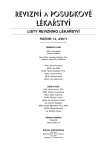Cerebral palsy
Authors:
D. Šišková
Authors‘ workplace:
Oddělení dětské neurologie, Thomayerova nemocnice, Praha
Published in:
Reviz. posud. Lék., 14, 2011, č. 4, s. 127-132
Overview
Cerebral palsy (CP) is a disease with an early impairment of movement and other co-morbidities. It is caused by non-progressive damage of the immature developing brain during the pre-, peri- and postnatal period. Prevalence is reported approximately 2 in 1000 newborns. The highest incidence occurs in children of an extremely low birth-weight. Cerebral palsy is caused mainly by prematurity, birth asphyxia or traumatism. Other causes include infections, developmental impairment and vascular problems. According to clinical neurological findings we divide cerebral palsy into most frequent spastic (quadriparesis, hemiparesis and diaparesis), dystonic-dyskinetic and atactic forms. It is possible to classify the functional level by GMFCS (Gross Motor Function Classification System). It is not possible to cure the cerebral palsy, to achieve a normal condition. The therapy is effective in a team and it is not aimed at motor skills only (physiotherapy, botulinum toxin, orthopaedic treatment) but also at the sensoric development (opthalmology, phoniatrics), the treatment of epilepsy, care for the psychological and social development, development of speech and education.
Key words:
cerebral palsy (CP) – CP classification – causes of CP – CP diagnostics – complex CP therapy
Sources
1. Menkes, J. H. et al. Dětská neurologie. Praha: Triton 2011, s. 525–558.
2. Kraus, J., Zoban, P., Schejbalová, A. Dětská mozková obrna – hlavní téma. Neurologie pro praxi, 2011, 12, 4.
3. Muchová, M. Botulotoxin A v léčbě dětské mozkové obrny. Pediatrie pro praxi, 2011, 12, 3.
Labels
Medical assessment Occupational medicineArticle was published in
Medical Revision

2011 Issue 4
Most read in this issue
- Vision defects and the medical expert opinion consequences for various aspects of medical expert opinion practice
- Cerebral palsy
- Support of rational pharmacotherapy and medical insurance companies – theory and practice
- Resuscitation and intensive care of suckling infants, children and adolescents from the view of physician review
